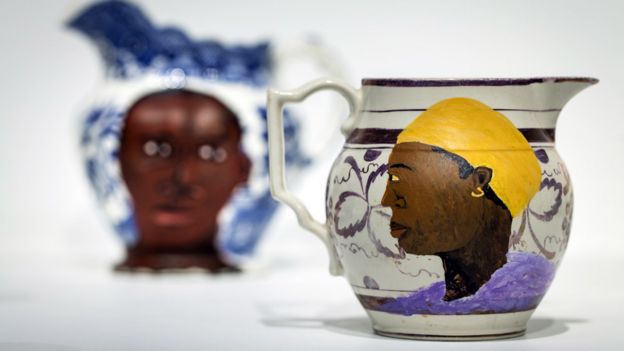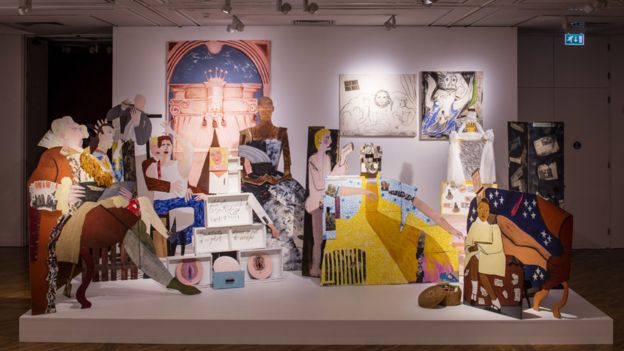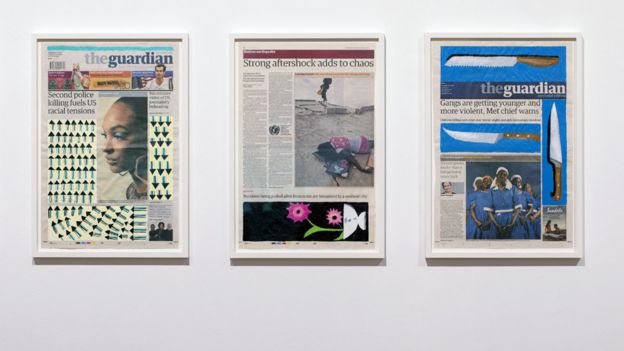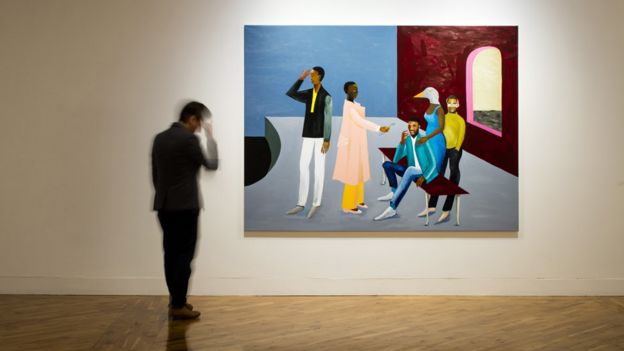I knew she would win!!!
That is what makes the difference between the UK and France, for me. Despite Brexit and despite the Conservative party still ruling the Parliament and government.
Honesty towards talent, history, outstanding contributions.
Congratulations to an amazing artist who was patient enough to keep on doing her amazingly profound and eye-opening artistic and beautiful work, despite the last of massive public recognition.
Because recognition is not why real artists keep on creating. They do because they have an authentic message to display and creative means to produce it.
-
Turner Prize 2017: Lubaina Himid's win makes history
Link to BBC article: http://www.bbc.com/news/entertainment-arts-42244324#
My quotes from it in a different order...
What the judges said:
The Turner Prize panel said they admired "her expansive and exuberant approach to painting which combines satire and a sense of theatre".
They also said they "acknowledged her role as an influential curator and educator who continues to speak urgently to the moment".
-
What the BBC put in their header:
Lubaina Himid has become the oldest winner of the Turner Prize, and the first black woman to pick up the art award.
The 63-year-old Zanzibar-born, Preston-based artist won the £25,000 prize for work addressing racial politics and the legacy of slavery.
The judges praised her "uncompromising tackling of issues including colonial history and how racism persists today".
She was named the winner at a ceremony in Hull, currently UK City of Culture.
 DAVID LEVENE
DAVID LEVENEWho is Lubaina Himid?
Described in February by The Daily Telegraph as "the under-appreciated hero of black British art", Himid made her name in the 1980s as one of the leaders of the British black arts movement - both painting and curating exhibitions of similarly overlooked artists.
But she's now got the recognition she deserves. Her section of the Turner Prize exhibition in Hull contains work from the 1980s to today, including wooden figures, pottery and newspapers that she has painted on.
The centrepiece is 1987's A Fashionable Marriage, based on William Hogarth's Marriage a la Mode, which features a cast of cut-out characters including a flirting Margaret Thatcher and Ronald Reagan.
 DAVID LEVENE
DAVID LEVENE
There are also porcelain dinner sets, found in junk shops. Himid has painted images of black slaves on some and aristocrats - some of whom are vomiting at the news of the abolition of slavery - on others.
She has also painted over parts of newspaper pages to show how they "used black people in a very subtle way which could be said to undermine their identity".
She is professor of contemporary art at the University of Central Lancashire and was made an MBE in 2010 for services to black women's art.
 DAVID LEVENE
DAVID LEVENE DAVID LEVENE
DAVID LEVENEThe Turner Prize grows up
After a change in the rules, this was the first time since 1991 that artists over the age of 50 were eligible for the prize, which used to be infamous for rewarding outrageous Young British Artists.
As well as Himid, 52-year-old Birmingham painter Hurvin Anderson made it on to this year's shortlist.
Tate Britain director Alex Farquharson, who chaired this year's jury, said there was a desire to celebrate artists who had previously been neglected by the mainstream.
And there was a very international feel to the shortlist, which also included Stuttgart-born Andrea Buttner and film-maker Rosalind Nashashibi, who was born in Croydon to Palestinian-Irish parents.
Their work is on show at the Ferens art gallery in Hull until 7 January.

Follow us on Facebook, on Twitter @BBCNewsEnts, or on Instagram at bbcnewsents. If you have a story suggestion email entertainment.news@bbc.co.uk.
---
Other BBC links:
-
Below is the article I wrote in March, after seeing Lubaina's fantastic exhibition in Bristol's Spike Island Gallery.
The website I wrote it for refused to publish it, saying that was not what they were expecting for their project on music, art and design...
Another of my articles on Lubaina Himid should be published soon, for another, more open, website.
Lubaina Himid
March 4, 17
-
By Melissa Chemam
-
Lubaina Himid,
and The Colours of Our Past
With a
carrier path of a pioneer, as one of the forefront representative of Black
artists in the U.K., Lubaina Himid is now at the centre of three concomitant
exhibitions in England, starting with Bristol’s very own Spike Island Gallery.
An unmissable occasion to plunge into her eye-opening and striking art.
Her art pieces seem to have come alive.
Painted on panels installed standing in the Spike Island Gallery’s main room,
accompanied with a sound system broadcasting these characters’ voices and with names
written on their back side, these portraits of African slaves leave you with a
powerful sense of both familiarity and estrangement.
A hundred cut-out figures thus representing
slaves in eighteenth-century European Royal courts are on display in her
Bristol exhibition, along with some of her large and smaller canvas. The soundtrack
and the names of the characters – mentioning both an original African name and
a newly given English name – create a whole conversation and bring about the
idea of fluid identities.
“I was very early on a political teenager,” Lubaina
Himid tells me on the phone from her home in Preston, a few days after the
Spike Island opening. “I went to marches, protests, it was part of my life. My
mother was a textile designer and she loved anything artistic, took me art
galleries, showed me the beautiful patterns she would use, so very early on I
was drawn to art that had a political force, especially Berthold Brecht and
this is why I was interested in theatre design. But I became even more aware
politically after turning twenty. I got interested in street theatre that was a
big thing in France in the late 1970s but not so much in Britain and I became
more confident about my own artistic expression. Then in the 80s, of course,
the political situation became more extreme in the U.K., and especially for
minorities.”
Born in Zanzibar in 1954, Lubaina Himid moved
to Britain as a child with her parents in the 1960s and grew up in London. She
started her pathway through the art world by studying theatre design, before
entering the Royal Art College and writing a thesis in cultural history on
young Black artists in Britain, released in 1984. A smashing accomplishment
that quickly took her to also support other artists’ debuts, including Sutapa
Biswas, Sonia Boyce, Claudette Johnson, Veronica Ryan, Indrid Pollard.
A Major Voice
for The Black British Culture
Lubaina became a curator in London in the
mid-80s and organised the Thin Black Line exhibition at the ICA (Institute
of Contemporary Arts) in 1985 for instance. Meanwhile, she was producing her
own art, influenced by her passion for “distanciation” in theatre and Berthold
Brecht. She works on both art installations and figurative painting, using
strong patterns, colours and themes. With references to slavery, forced labour,
colonial history, migration and the role of the “Black” diaspora in Europe, her
art obviously stands out in the British 1990s art scene. She later started
teaching history of contemporary arts at the University of Central Lancaster,
in Preston.
“The good thing for me is that working with
Black artists was never a lonely path. We did quite early some collaborative
exhibitions, with the Black Art Group, the Black Art Gallery; in London,
Nottingham, Bristol; it was the opposite of lonely. But it was a battle, and a
extra battle to say something political”.
The three exhibitions running this month of
March are a step forward in Lubaina’s carrier, and a chance to get her work
displayed nationwide, underlining her pioneering role and her forefront talent.
“The central theme is about how to achieve a
sense of belonging,” insists Lubaina, and especially as a specific population
of the country, with a slightly different history to say the least. “And it’s
about how to get a recognition of the contribution of the diasporas in our
culture,” she adds. “Slavery is very present in today’s Britain, it’s not only
an affair of the past, you see it when you look at so many buildings, at
people, it’s always around me and much more visible than it was in the 1980s.
Even if the detailed events related to slavery are not found in mainstream
history books, I believe every part of history impacts us all the time; it does
not go away”.
Art, according to her, has the power to open
a dialogue about such issues, to initiate conversations, and it is important.
“We can look at the past and just sincerely ask ‘where do we go from here?’ I
believe. I do think that the British people have so far been better at facing
the truth of history than the French for instance,” concludes Lubaina. And if
they can go further, it can become a source of richness, bonding and creativity
for the entire society.
-
Exhibitions
details:
Navigation Charts is at Spike Island, Bristol from 20 January to 26
March; Invisible Strategies is at Modern Art Oxford from 21 January to 30
April; The Place is Here is at Nottingham Contemporary from 4 February at 30
April.
No comments:
Post a Comment